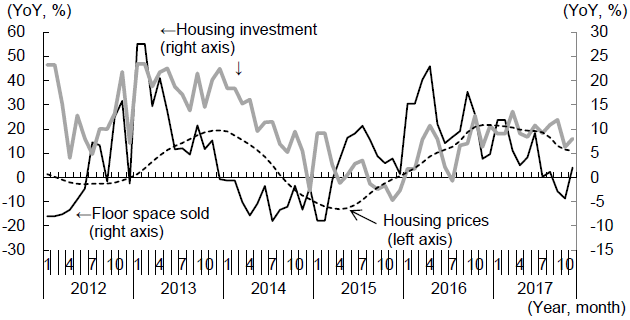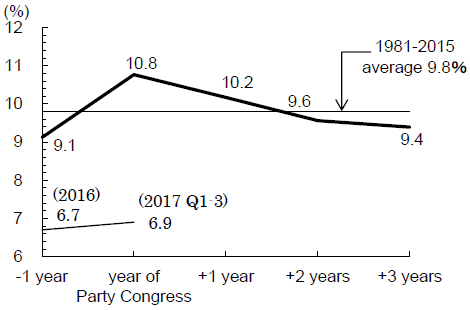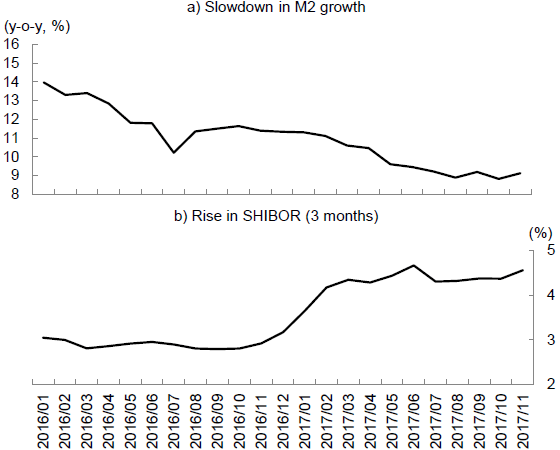China's economic growth rate is expected to decline in 2018, thanks to investment restrictions imposed by the government to reduce excess production capacity in certain industries, adjustments in the housing market, slowing down of infrastructure investment in accordance with the "political business cycle," and the monetary authorities' effort to reduce financial risk by tightening monetary policy. Going forward, in order to maintain medium to high speed growth, it will be necessary to deepen reform and opening centered on marketization. The details of the economic reform agenda of the Xi Jinping administration in its second term is expected to be announced at the Third Plenary Session of the 19th Central Committee of the Communist Party of China in the fall of 2018.
Expected decline in growth rate
As part of its supply-side structural reform, China has made progress in reducing excess production capacity in certain industries, including steel and coal. Against this backdrop, some have argued that, led by a rebound in investment, the Chinese economy is ready to enter the expansion phase of its business cycle, or "new cycle." However, economic activity is shifting from the manufacturing sector to the service sector, and, in industries where excess production capacity is a serious problem, demand might have already peaked out and entered a stage of long-term decline. As a result, a strong recovery in investment seems unlikely.
In addition, housing market adjustments will impose further downward pressure on economic growth. Housing prices in the first-tier cities such as Beijing and Shanghai have risen sharply, with their ratios of housing prices to annual income exceeding that of Tokyo in the bubble period. In response, the government has adopted control measures, such as strengthening restrictions on housing loans and the number of new homes individuals can purchase. As a result, growth in the floor space sold, housing prices, and housing investment have begun to slow (Figure 1). Further adjustment in the housing market is expected in 2018. However, a sharp fall in housing prices will not only worsen the economy through a reduction in housing investment, but also destabilize the financial system through an increase in nonperforming loans at the banks, as happened in Japan in the 1990s following the bursting of the asset bubble.

Furthermore, economic fluctuations in China tend to follow a five-year cycle in which the growth rate peaks in the year of the National Congress of the Communist Party of China (Party Congress). This "political business cycle" can be explained by the fact that is there is a strong tendency for the implementation of large scale investment projects, such as infrastructure construction contained in the Five-year Plans, to be concentrated in the year of the Party Congress. For the period 1981-2015, while China's economic growth rate averaged 9.8%, it reached an average 10.8% in the years in which the Party Congress was held, and fell in subsequent years to an average 10.2% in "Party Congress + 1 year," 9.6% in "Party Congress + 2 years," 9.4% in "Party Congress + 3 years," and 9.1% in "Party Congress - 1 year" (the year before the next Party Congress) (Figure 2). In 2017, when the 19th Party Congress was held, the year-on-year growth rate for the first three quarters was 6.9%, and the year-round rate should also exceed the previous year's rate of 6.7%. This historic pattern suggests that China's economic growth in 2018, which is the year following the latest Party Congress, may slow down.

Risk prevention via monetary tightening
Since the Lehman Brothers collapse in 2008, led by the corporate sector, debts in China have been increasing rapidly. International organizations including the International Monetary Fund (IMF) and the Bank for International Settlements (BIS) have been voicing concerns that the expansion of bad debts held by banks due to the slowdown in the Chinese economy may trigger an economic crisis. In the Central Economic Work Conference (December 18-20, 2017), in which the stance of economic policy for 2018 was decided, the prevention and control of serious risks, financial risk in particular, were raised as one of the "three tough battles" for the next three years, together with poverty eradication and pollution measures. Thus, it has become clear that the government's priority in the trade-off between growth and stability in its macroeconomic policy has shifted from the former to the latter.
In fact, in formulating monetary policy, the authorities, which had for a long time focused on curbing the business cycle as represented mainly by price fluctuations, have come to paid more attention to curbing the financial cycle as represented mainly by fluctuations in real estate prices (The People's Bank of China, "China Monetary Policy Report" 3rd quarter 2017, November 17, 2017). Reflecting this, although the inflation rate as measured by the year-on-year increase in the consumer price index (CPI) has remained at a low level (1.7% year-on-year in November, 2017), the authorities have maintained a tight stance of monetary policy, as shown by the slowdown in M2 money supply growth and the sharp rise in the Shanghai Interbank Offered Rate (SHIBOR) (Figure 3). Although housing prices have peaked out, they have stayed at a very high level. Thus, the current tight stance of monetary policy is likely to be maintained in 2018.

Taken together, the Chinese economy in 2018 is expected to enter an adjustment phase due to deceleration of investment, rather than an upward phase of the new cycle pulled by investment, with the growth rate dropping below 6.5%.
New reform measures to be announced in the Third Plenary Session in the fall of 2018
In China, against the backdrop of the labor market turning from surplus to shortage, the potential growth rate has declined sharply, and improved productivity will be the key to maintaining the current pace of medium to high speed growth. Thus, China needs to deepen reform and opening centered on marketization, rather than just implementing supply-side structural reform that focuses on reducing excess production capacity. To this end, General Secretary Xi Jinping raised the following six priority areas of economic reform in his report at the Party Congress in October 2017:
1. Furthering supply-side structural reform
2. Making China a country of innovators
3. Pursuing a rural vitalization strategy
4. Implementing the coordinated regional development strategy
5. Accelerating efforts to improve the socialist market economy
6. Making new ground in pursuing opening up on all fronts
Details of these economic reforms are due to be announced at the Third Plenary Session of the 19th Central Committee of the Communist Party of China in the fall of 2018.
In the Third Plenary Session of the 18th Central Committee of the Communist Party of China held in the fall of 2013, the determination of the leadership in attempting to promote market-oriented reform could be seen in their decision "to allow the market to play a decisive role in resource allocation." However, looking back, it seems clear that market-oriented reform stagnated under the first term of the Xi Jinping administration, which began in 2012. Whether the upcoming Third Plenary Session will trigger a new round of market-oriented reform should be closely watched.
The original text in Japanese was posted on January 9, 2018.


